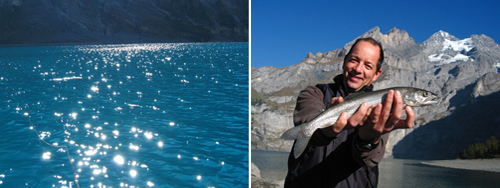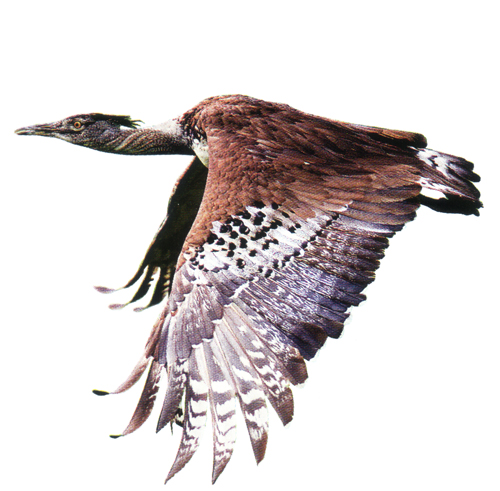On October 14, 2007, I fished the Oeschinen flats with my friend Martin whom I had met in Ireland earlier that year during a flyfishing for salmon week organized in Screebe by the Hebeisen Flyfishing School. Oeschinen flats, what the hell is this? Well, this is what we call the shallow parts of lake Oeschinen which is located in the Bernese Alps above Kandersteg. Lake Oeschinen is fed with waters from numerous glaciers around the Bluemlisalp mountain and it has an underground outflow. Now in autumn when it gets again colder there is hardly any water flowing into the lake, most waterfalls have stopped, and thus the lake level starts dropping. At the end of the winter, the water level is usually 15 to 20 meters below summer level. This is why some parts at the rear end of the lake become shallow.
We started fishing with streamers at one of the inflows of the lake. Soon we saw the first fish following our streamers right up to the boat. Good to know that there were fish around. A little later I spotted a fish rising regularly near the inflow. I positioned our boat and Martin started casting his dry fly. The fish came on the second cast. It was Martin's first Namaycush and he was very excited that he had landed it on a dry fly, a dark Klinkhammer parachute. There was another fish rising in this spot and I gave it a go with my Royal Wulff, but the fish didn't take, maybe it was spooked. The water was in fact crystal clear and we could see down to the bottom of the lake. We could see the fish as well as they could see us.

We continued further onto the south eastern part of the lake where now the water was very shallow and we could observe fish cruising around and rising to take insects from the surface. This was a flyfisherman's heaven: polaroiding and fishing on sight. I rowed the boat, followed the fish and put the boat into position. Martin was standing and casting his dry flies, very much like one would do in the Caribbean flats when fishing for bonefish. Many fish came up to the fly but did not take. Time for a change and a smaller fly. Now the fish eagerly took the fly, but it was hard to keep them on and we lost quite a few. After a while it was my turn to fish and Martin took the commands of the boat. Soon I had spotted a rising fish. I casted my fly, it took but I missed it. A little further I saw another one. A few seconds later my fly was on the right spot and taken almost instantly. After a short fight, I had also landed a nice Namaycush.
We continued to fish the flats as well as other parts of the lake. I lost a nice rainbow trout which came to my fly right next to the shore. Right before we finished fishing, Martin lost a fish that rose several times on its cruising path. He casted his fly onto the fish's path and it was taken immediately. It was a nice fish, probably a rainbow trout too, but it managed to come off.
We had a great time on this superb mountain lake. The fact that we could fish with dry flies made this fishing trip even more spectacular.
Have a look at my other blog entries at www.flyfisherjournal.com

